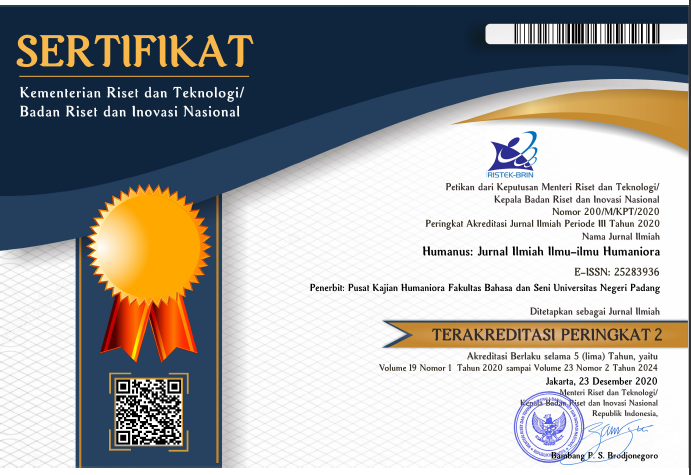Commentary on Women’s Body: Shedding Lights on Verbal Sexual Harassment in Indonesia
 ), Farieda Ilhami Zulaikha(2),
), Farieda Ilhami Zulaikha(2), (1) Universitas Gadjah Mada
(2) the University of Sydney
 Corresponding Author
Corresponding Author
Copyright (c) 2025 Suhandano Suhandano, Farieda Ilhami Zulaikha
DOI : https://doi.org/10.24036/humanus.v24i1.127227
Full Text:
 Language : en
Language : en
Abstract
Keywords
References
Aanesen, S. M., Notøy, R. R. G., & Berg, H. (2020). The Re-shaping of Bodies: A Discourse Analysis of Feminine Athleticism. Frontiers in Psychology, 11, 1751. https://doi.org/10.3389/fpsyg.2020.01751
Beauvoir, S. de. (1989). The second sex (H. M. Parshley, Ed.). Vintage.
Brookfield, M. (2023). The Girl Watcher: Celebrating a Man’s Right to Look in the Post-war USA. Gender and History, 1–18. https://doi.org/10.1111/1468-0424.12698
Burn, S. M. (2019). The Psychology of Sexual Harassment. Teaching of Psychology, 46(1), 96–103. https://doi.org/10.1177/0098628318816183
Butler, J. (1988). Performative Acts and Gender Constitution: An Essay in Phenomenology and Feminist Theory. Theatre Journal, 40(4), 519–531. https://doi.org/10.2307/3207893
Cesario, B. (2020). Attitudes about viremarksctims of workplace sexual harassment based on sex. Current Research in Behavioral Sciences, 1, 100006. https://doi.org/10.1016/j.crbeha.2020.100006
Dewi, I. A. A. (2019). Catcalling : Candaan, Pujian atau Pelecehan Seksual. Acta Comitas, 4(2). https://doi.org/10.24843/AC.2019.v04.02.p.04
Drązkowski, D., & Ganclerz, M. (2022). Social perception of sexual harassment in informal relations. Current Issues in Personality Psychology, 10(3), 227–233. https://doi.org/10.5114/cipp.2021.110026
Emeksiz, G. I. (2021). The Stereotypical Representation of Females in Women’s Health Magazine’s Cosmetic Advertisements. Open Journal of Social Sciences, 09, 53–70. https://doi.org/10.4236/jss.2021.99005
Fatura, F. N. (2019). Telaah tindak pidana pelecehan seksual secara verbal dalam hukum pidana Indonesia. Recidive, 8(3), 238–244. https://tirto.id/kasus-agni-berakhir-damai-cermin-buram-kasus-pelecehan-di-kampus-
Fitzgerald, L. F., Magley, V. J., Drasgow, F., & Waldo, C. R. (1999). Measuring Sexual Harassment in the Military: The Sexual Experiences Questionnaire (SEQ—DoD). Military Psychology, 11(3), 243–263. https://doi.org/10.1207/s15327876mp1103_3
Geeraerts, D. (1989). Introduction: Prospects and problems of prototype theory. Linguistics, 27(4), 587-612. https://doi.org/10.1515/ling.1989.27.4.587
Geeraerts, D., & Cuyckens, H. (2010). The Oxford Handbook of Cognitive Linguistics. Oxford University Press.
Gravelin, C. R., Biernat, M., & Bucher, C. E. (2019). Blaming the victim of acquaintance rape: Individual, situational, and sociocultural factors. Frontiers in Psychology, 9, 2422. https://doi.org/10.3389/fpsyg.2018.02422
Green, J. F. (2022). Smashing Backdoors in and the Wandering Eye: An Introduction to Bartenders’ Experiences with Unwanted Sexual Attention while Working in the UK. Feminist Criminology, 17(1), 96–115. https://doi.org/10.1177/15570851211001922
Hehman, J. A., Salmon, C. A., Pulford, A., Ramirez, E., & Jonason, P. K. (2022). Who perceives sexual harassment? Sex differences and the impact of mate value, sex of perpetrator, and sex of target. Personality and Individual Differences, 185, 111288. https://doi.org/https://doi.org/10.1016/j.paid.2021.111288
Hu, Y. (2018). Exploration of How Female Body Image Is Presented and Interpreted on Instagram. Advances in Journalism and Communication, 06, 95–120. https://doi.org/10.4236/ajc.2018.64009
Johnson, S. K., Keplinger, K., Kirk, J. F., & Chan, E. T. (2018). The perils of pretty: Effects of personal appearance on women’s careers. In A. M. Broadbridge & S. L. Fielden (Eds.), Research Handbook of Diversity and Careers (pp. 129–143). Edward Elgar Publishing. https://doi.org/10.4337/9781785365607.00016
Juliantara, D., Thofly, H., & Aunuh, N. (2021). Analisis Viktimologis Pelecehan Seksual Verbal di Wilayah Hukum Kota Malang (Studi di Polresta Kota Malang). Indonesia Law Reform Journal, 1(3), 442–453.
Karami, A., White, C. N., Ford, K., Swan, S., & Yildiz Spinel, M. (2020). Unwanted advances in higher education:Uncovering sexual harassment experiences in academia with text mining. Information Processing and Management, 57(2). https://doi.org/10.1016/j.ipm.2019.102167
Karandashev, V. (2019). Cross-Cultural Perspectives on the Experience and Expression of Love. In Cross-Cultural Perspectives on the Experience and Expression of Love. Springer International Publishing. https://doi.org/10.1007/978-3-030-15020-4
Kellie, D. J., Blake, K. R., & Brooks, R. C. (2019). What drives female objectification? An investigation of appearance-based interpersonal perceptions and the objectification of women. PLoS ONE, 14(8), e0221388. https://doi.org/10.1371/journal.pone.0221388
Krieger, M. A., Santarossa, S., Bours, S., & Woodruff, S. J. (2022). Men’s comments on elite women athletes: cultural narratives around gender and sport on Instagram. Feminist Media Studies. https://doi.org/10.1080/14680777.2022.2041696
Lameiras-Fernández, M., Fiske, S. T., Fernández, A. G., & Lopez, J. F. (2018). Objectifying Women’s Bodies is Acceptable from an Intimate Perpetrator, at Least for Female Sexists. Sex Roles, 79(3–4), 190–205. https://doi.org/10.1007/s11199-017-0862-8
McComb, S. E., & Mills, J. S. (2021). Young women’s body image following upwards comparison to Instagram models: The role of physical appearance perfectionism and cognitive emotion regulation. Body Image, 38, 49–62. https://doi.org/10.1016/j.bodyim.2021.03.012
McLaughlin, H., Uggen, C., & Blackstone, A. (2012). Sexual Harassment, Workplace Authority, and the Paradox of Power. American Sociological Review, 77(4), 625–647. https://doi.org/10.1177/0003122412451728
Mills, J. S., Shannon, A., & Hogue, J. (2017). Beauty, Body Image, and the Media. In M. Levine (Ed.), Perception of Beauty (pp. 145–157). IntechOpen. https://doi.org/10.5772/intechopen.68944
MoWECP. (2022). SIMFONI-PPA (Online Information System for the Protection of Women and Children).
Nida, E. A. (1979). A Componential Analysis of Meaning. In An Introduction to Semantic Structures. De Gruyter Mouton. https://doi.org/doi:10.1515/9783110828696
Nilan, P., Demartoto, A., Broom, A., & Germov, J. (2014). Indonesian men’s perceptions of violence against women. Violence Against Women, 20(7), 869–888. https://doi.org/10.1177/1077801214543383
Nurbayani, S., Dede, Moh., & Widiawaty, M. A. (2022). Utilizing library repository for sexual harassment study in Indonesia: A systematic literature review. Heliyon, 8(8), 1–8. https://doi.org/https://doi.org/10.1016/j.heliyon.2022.e10194
Pinal, G. del. (2016). Prototypes as compositional components of concepts. 193(9), 2899–2927. https://doi.org/10.1007/sl
Razvaliaeva, A. Y., & Polskaya, N. A. (2021). Validating appearance-based rejection sensitivity and fear of negative appearance evaluation scales in the russian sample. Counseling Psychology and Psychotherapy, 28(4), 118–143. https://doi.org/10.17759/CPP.2020280407
Reed, E., Salazar, M., Agah, N., Behar, A. I., Silverman, J. G., Walsh-Buhi, E., Rusch, M. L. A., & Raj, A. (2019). Experiencing sexual harassment by males and associated substance use & poor mental health outcomes among adolescent girls in the US. SSM - Population Health, 9, 100476. https://doi.org/10.1016/j.ssmph.2019.100476
Riemer, H., Shavitt, S., Koo, M., & Markus, H. R. (2014). Preferences don’t have to be personal: Expanding attitude theorizing with a cross-cultural perspective. Psychological Review, 121(4), 619–648. https://doi.org/10.1037/a0037666
Rostami, F. (2021). An analysis of sexual harassment on Iranian campuses. International Journal of Educational Development, 87, 102498. https://doi.org/10.1016/J.IJEDUDEV.2021.102498
Santoniccolo, F., Trombetta, T., Paradiso, M. N., & Rollè, L. (2023). Gender and Media Representations: A Review of the Literature on Gender Stereotypes, Objectification and Sexualization. International Journal of Environmental Research and Public Health, 20(10), 5770. https://doi.org/10.3390/ijerph20105770
Smith, M. D. (2020). Sexual harassment : a reference handbook (EBSCOhost, Ed.). ABC-CLIO, LLC.
Smith-Hefner, N. J. (2019). Youth, Sexuality, and Gender in Contemporary Indonesia. University of Hawai’i Press. https://doi.org/10.2307/j.ctv7r43bt
Steinem, G. (2019). Outrageous Acts and Everyday Rebellions (3rd ed.). Open Road Integrated Media LLC.
Stewart, S. J., & Ogden, J. (2021). The impact of body diversity vs thin-idealistic media messaging on health outcomes: an experimental study. Psychology, Health and Medicine, 26(5), 631–643. https://doi.org/10.1080/13548506.2020.1859565
Venäläinen, S., Aaltonen, S., & Phoenix, A. (2023). Making Sense of Sexual Harassment Over Time: Young Women’s and Nonbinary People’s Accounts in 2000 and 2021. NORA - Nordic Journal of Feminist and Gender Research, 31(4), 367–380. https://doi.org/10.1080/08038740.2023.2207041
Vohlídalová, M. (2011). The Perception and Construction of Sexual Harassment by Czech University Students. In Sociological Review (Vol. 47, Issue 6).
Webb, H. J., Zimmer-Gembeck, M. J., Waters, A. M., Farrell, L. J., Nesdale, D., & Downey, G. (2017). “Pretty Pressure” From Peers, Parents, and the Media: A Longitudinal Study of Appearance-Based Rejection Sensitivity. Journal of Research on Adolescence, 27(4), 718–735. https://doi.org/10.1111/jora.12310
Wolfendale, J. (2015). Provocative Dress and Sexual Responsibility. Georgetown Journal of Gender and the Law, 18(1). https://doi.org/10.2139/ssrn.2591440
Wood, R. (2024). From aesthetic labour to affective labour: feminine beauty and body work as self-care in UK ‘lockdown.’ Gender, Place and Culture, 31(1), 82–101. https://doi.org/10.1080/0966369X.2023.2192892
 Article Metrics
Article Metrics
 Abstract Views : 50 times
Abstract Views : 50 times
 PDF Downloaded : 16 times
PDF Downloaded : 16 times
Refbacks
- There are currently no refbacks.
Copyright (c) 2025 Suhandano Suhandano, Farieda Ilhami Zulaikha

This work is licensed under a Creative Commons Attribution-NonCommercial 4.0 International License.










